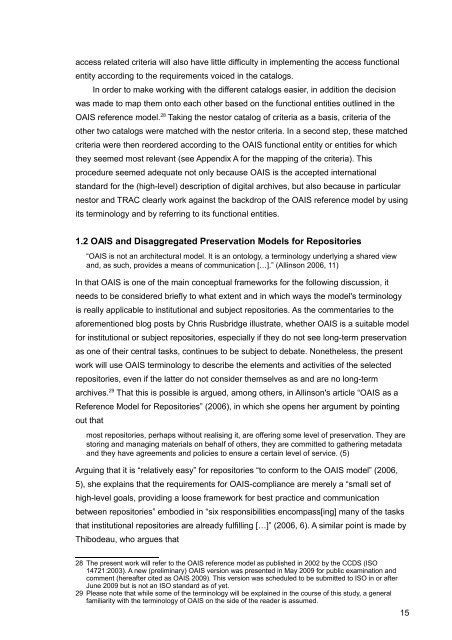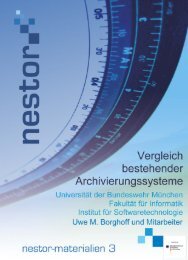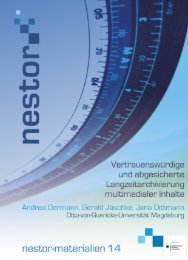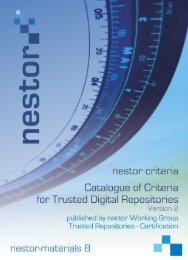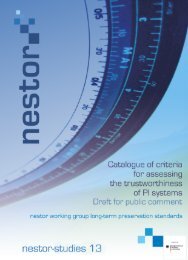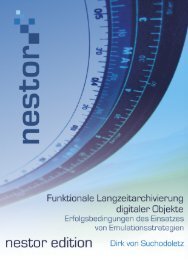German repositories have already been awarded the 2004 or 2007 DINI Certificate. Thenestor catalog is in the process of being transformed into a DIN standard 26 , and TRACforms the basis of the efforts of the Birds of a Feather (BOF) working group currentlycreating a document to be submitted to ISO for consideration as an internationalstandard. 27This study uses selected criteria from the above-mentioned catalogs to investigatethe approaches to long-term preservation taken by the three repositories on which it willfocus. The benefits which can be gained from this, even if the repositories to which thecatalogs will be applied do not aim at becoming long-term archives themselves, aredescribed in a recent article by Steinhart, Dietrich, and Green in which they summarizetheir experiences in applying the TRAC criteria to DataStaR, a data-staging repositorycurrently developed at Cornell University. As they explain, theydecided to investigate and incorporate best practices related to digital preservation to the fullestextent possible even though DataStaR is not intended to serve as a long-term preservationrepository […]. There are good reasons for taking this approach. First, […] policies and bestpractices for repositories seem to be best developed in the digital preservation community, anddigital preservation frameworks have much to offer that bears on responsible management ofrepositories, regardless of a repository's stated preservation commitment [...]. Digitalpreservation frameworks also emphasize the importance of establishing trust, and howrepositories can demonstrate trustworthiness with certain kinds of evidence. (2009, no pag.)As this quotation indicates, traditional repository tasks and long-term preservation tasksare not as far removed from each other as one might think: thus, trustworthiness issomething that both traditional and preservation-centered repositories should strive toachieve. At the same time, the observations of Steinhart et al. serve to “justify” theapproach taken in this study, which uses the criteria catalogs introduced above asguidelines as to which aspects need to be considered in particular if a repository wants tobe prepared to take at least a shared responsibility for the long-term preservation of itsdigital assets, that is, without becoming a long-term archive itself.In order to keep this study within the set limits (both with regard to time and tolength), the number of criteria used has been reduced. <strong>Not</strong> only were some criteria simplynot relevant in the current context, but also the decision was made to focus in particularon the actual management of digital objects (implemented procedures carried out both byhuman staff and software-aided) as well as the areas of policy and technicalinfrastructure. Finally, the (organizational and disciplinary) context in which eachrepository is embedded was also considered briefly. In contrast, despite their importancecriteria dealing primarily with questions of user access have been largely disregarded forthe reasons just mentioned. Instead I have worked based on the assumption (whether thisis entirely justified is certainly to be questioned) that a repository which fulfills the non-26 A first version of the standard was scheduled to be presented in the DIN Standards Committee meeting onOctober 13, 2009 (cf. the timetable of the nestor working group “Vertrauenswürdige Archive” onhttp://www.langzeitarchivierung.de – 30.10.2009).27 See http://wiki.digitalrepositoryauditandcertification.org/bin/view for further details – 30.10.2009.14
access related criteria will also have little difficulty in implementing the access functionalentity according to the requirements voiced in the catalogs.In order to make working with the different catalogs easier, in addition the decisionwas made to map them onto each other based on the functional entities outlined in theOAIS reference model. 28 Taking the nestor catalog of criteria as a basis, criteria of theother two catalogs were matched with the nestor criteria. In a second step, these matchedcriteria were then reordered according to the OAIS functional entity or entities for whichthey seemed most relevant (see Appendix A for the mapping of the criteria). Thisprocedure seemed adequate not only because OAIS is the accepted internationalstandard for the (high-level) description of digital archives, but also because in particularnestor and TRAC clearly work against the backdrop of the OAIS reference model by usingits terminology and by referring to its functional entities.1.2 OAIS and Disaggregated Preservation Models for Repositories“OAIS is not an architectural model. It is an ontology, a terminology underlying a shared viewand, as such, provides a means of communication […].” (Allinson 2006, 11)In that OAIS is one of the main conceptual frameworks for the following discussion, itneeds to be considered briefly to what extent and in which ways the model's terminologyis really applicable to institutional and subject repositories. As the commentaries to theaforementioned blog posts by Chris Rusbridge illustrate, whether OAIS is a suitable modelfor institutional or subject repositories, especially if they do not see long-term preservationas one of their central tasks, continues to be subject to debate. Nonetheless, the presentwork will use OAIS terminology to describe the elements and activities of the selectedrepositories, even if the latter do not consider themselves as and are no long-termarchives. 29 That this is possible is argued, among others, in Allinson's article “OAIS as aReference Model for Repositories” (2006), in which she opens her argument by pointingout thatmost repositories, perhaps without realising it, are offering some level of preservation. They arestoring and managing materials on behalf of others, they are committed to gathering metadataand they have agreements and policies to ensure a certain level of service. (5)Arguing that it is “relatively easy” for repositories “to conform to the OAIS model” (2006,5), she explains that the requirements for OAIS-compliance are merely a “small set ofhigh-level goals, providing a loose framework for best practice and communicationbetween repositories” embodied in “six responsibilities encompass[ing] many of the tasksthat institutional repositories are already fulfilling […]” (2006, 6). A similar point is made byThibodeau, who argues that28 The present work will refer to the OAIS reference model as published in 2002 by the CCDS (ISO14721:2003). A new (preliminary) OAIS version was presented in May 2009 for public examination andcomment (hereafter cited as OAIS 2009). This version was scheduled to be submitted to ISO in or afterJune 2009 but is not an ISO standard as of yet.29 Please note that while some of the terminology will be explained in the course of this study, a generalfamiliarity with the terminology of OAIS on the side of the reader is assumed.15
- Page 6: AbstractTaking its cue from the inc
- Page 13: and benefit from the development an
- Page 20 and 21: [t]he Open Archival Information Sys
- Page 22 and 23: Thus it seems highly recommendable
- Page 24 and 25: actively pursuing the long-term pre
- Page 26 and 27: Like pedocs, the repository is not
- Page 28 and 29: application for a project grant was
- Page 30 and 31: generating an Archival Information
- Page 32 and 33: Integrity can be defined as “comp
- Page 34 and 35: It is with this step that the metad
- Page 36 and 37: documents submitted to the reposito
- Page 38 and 39: [t]he majority of OCR software supp
- Page 40 and 41: One of the shortcomings of the soft
- Page 42 and 43: set of shared metadata which is the
- Page 44 and 45: document, and that hence the docume
- Page 46: Structural metadata: In DSpace it i
- Page 49 and 50: dc.description.provenancedc.descrip
- Page 51 and 52: Für die Langzeitverfügbarkeit der
- Page 53 and 54: ecord for a title; although a workf
- Page 55 and 56: Source (where applicable)Publicatio
- Page 57 and 58: checksums. In particular, TRAC requ
- Page 59 and 60: checksums are currently not checked
- Page 61 and 62: 2.4.2 JUWEL Data ManagementThe stru
- Page 63 and 64: Before any SIPs are accepted, the r
- Page 65 and 66: guarantee that documents are “arc
- Page 67 and 68:
pedocs is a scholarly open access d
- Page 69 and 70:
formats. 151 Although the possible
- Page 71 and 72:
While the preferred file format is
- Page 73 and 74:
from nestor criterion 8, making it
- Page 75 and 76:
preserved for the long term, will h
- Page 77 and 78:
It seems that of all three reposito
- Page 79 and 80:
associated with them, or has define
- Page 81 and 82:
versioning functionality which allo
- Page 83 and 84:
communication channels, responsibil
- Page 85 and 86:
Works CitedAllinson, Julie (2006):
- Page 87 and 88:
DSpace Homepage. http://www.dspace.
- Page 89 and 90:
Lynch, Clifford A. (2000): Authenti
- Page 91 and 92:
in the EU. Amsterdam: Amsterdam Uni
- Page 93 and 94:
Ingestnestor TRAC DINIReceive Submi
- Page 95 and 96:
Archival Storagenestor TRAC DINIRec
- Page 97 and 98:
Archival Information Update10.4 Das
- Page 99 and 100:
Preservation PlanningnestorMonitor


